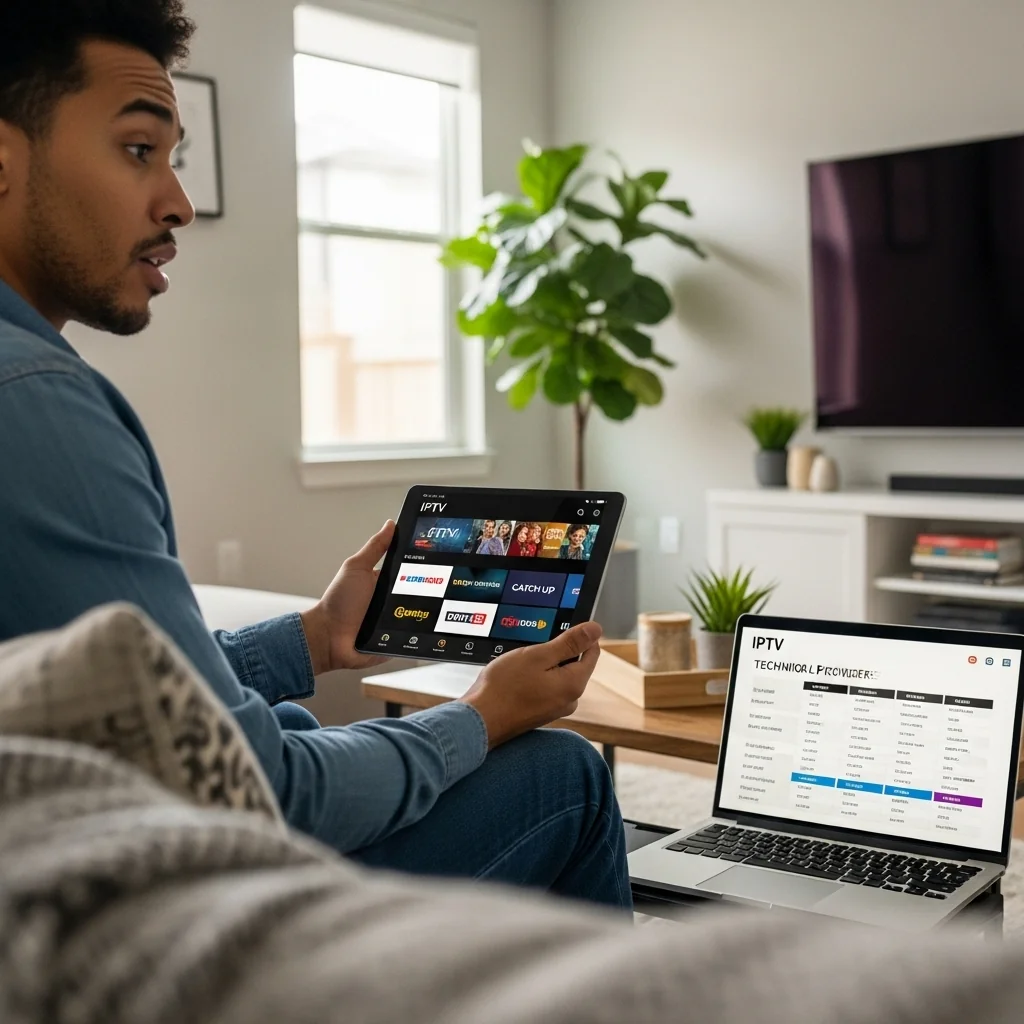Stop panicking about missing your favorite shows – modern IPTV catch-up features let you watch what you want, when you want, without the stress of rigid TV schedules.
What is Catch-Up TV on IPTV and Why You Need It
Catch-up TV on IPTV represents a mission-critical capability that transforms how service members and their families consume television content. Unlike traditional broadcast television that operates on fixed schedules, IPTV catch-up functionality allows users to access previously aired content on-demand, typically for a window of 7 to 30 days after the original broadcast. This technology operates through advanced server infrastructure that automatically records and stores broadcast content, making it available for streaming at any time within the retention period. For military personnel dealing with unpredictable schedules, deployment rotations, and time zone changes, this capability becomes essential rather than optional.
Strategic Advantages for Military Families
The operational benefits of catch-up TV extend far beyond civilian convenience. Military families face unique challenges that make traditional television scheduling incompatible with their lifestyle requirements.Deployment and duty schedule flexibility represents the primary tactical advantage. When you’re pulling night shifts, participating in training exercises, or managing family responsibilities across multiple time zones, the ability to access content on your timeline becomes mission-critical. Catch-up TV eliminates the frustration of missing important shows, news broadcasts, or family programming due to operational commitments.
- Access to news and current events programming regardless of duty schedule
- Family entertainment options that accommodate varying work shifts
- Educational content availability for military children with non-standard schedules
- International programming for overseas assignments and deployments
Technical Infrastructure Requirements
Understanding the technical foundation helps military users make informed decisions about IPTV services. Catch-up TV requires robust server capacity and bandwidth allocation from the service provider. The system must continuously record multiple channels simultaneously while serving on-demand content to thousands of concurrent users. Storage requirements are substantial, with providers typically maintaining terabytes of content across their catch-up libraries. This infrastructure investment directly impacts service quality and reliability, making provider selection crucial for consistent performance.
How IPTV Catch-Up Features Actually Work
The technical architecture behind IPTV catch-up functionality operates through sophisticated recording and streaming systems that military users should understand for optimal utilization. The process begins with automated content capture at the provider’s data centers, where specialized servers continuously monitor and record broadcast streams from multiple channels simultaneously. Content ingestion occurs in real-time, with digital video recorders (DVRs) at the network level capturing every minute of programming across the channel lineup. This differs fundamentally from personal DVR systems, as the recording happens centrally and serves all subscribers rather than individual households.
Server Architecture and Content Management
The backend infrastructure utilizes redundant server clusters designed for high availability and fault tolerance. Content gets processed through multiple stages: initial capture, encoding optimization, metadata tagging, and distribution preparation. Each recorded program receives unique identifiers and time stamps that enable precise retrieval and streaming. Storage systems employ hierarchical data management strategies, with frequently accessed content maintained on high-speed storage while older content migrates to more cost-effective storage tiers. This approach ensures optimal performance for recent content while maintaining accessibility for the full retention period.
- Real-time content capture across multiple channels simultaneously
- Automated encoding and compression for efficient storage and streaming
- Metadata extraction for program identification and search functionality
- Content lifecycle management with automated deletion after retention periods
- Load balancing systems for concurrent user access
User Interface and Content Discovery
The client-side experience relies on electronic program guide (EPG) integration that displays both live and catch-up content within unified interfaces. Users navigate through time-shifted programming using familiar grid layouts, with visual indicators distinguishing between live broadcasts and available catch-up content. Search functionality becomes particularly powerful with catch-up TV, allowing users to locate specific programs, episodes, or even segments within shows. Advanced filtering options enable sorting by genre, channel, date range, or content rating, making content discovery efficient even with extensive libraries.
Top IPTV Services with Reliable Catch-Up Functionality
Selecting an IPTV provider with robust catch-up capabilities requires evaluation of multiple technical and operational factors. Military users need services that maintain consistent performance across various network conditions and geographic locations, particularly for overseas assignments and deployments. Provider reliability becomes paramount when catch-up functionality serves as a primary entertainment source. Service level agreements (SLAs) and uptime guarantees should factor heavily into selection decisions, as should the provider’s track record for maintaining service during high-demand periods.
Enterprise-Grade IPTV Solutions
Several providers have established themselves as leaders in catch-up TV functionality, offering military-grade reliability and performance. These services typically maintain catch-up libraries spanning 14 to 30 days, with some premium offerings extending to 60 days or more for select content.
| Provider Category | Catch-Up Window | Channel Coverage | Reliability Rating |
|---|---|---|---|
| Premium Services | 30+ days | 500+ channels | 99.5% uptime |
| Standard Services | 7-14 days | 200-400 channels | 98.5% uptime |
| Budget Services | 3-7 days | 100-200 channels | 95-97% uptime |
Evaluation Criteria for Military Users
Network infrastructure and global reach represent critical evaluation factors. Providers with multiple data centers and content delivery networks (CDNs) offer superior performance for military families stationed worldwide. Look for services with dedicated servers in regions where you’re likely to be stationed. Content variety within catch-up libraries varies significantly between providers. Some focus heavily on entertainment programming while others maintain comprehensive news and documentary archives. Military-relevant programming such as news channels, educational content, and family programming should receive priority consideration.
- Global server infrastructure with low-latency access points
- Comprehensive channel lineup including news, sports, and entertainment
- Mobile application support for tablets and smartphones
- Multiple concurrent stream allowances for family use
- Customer support with military-friendly policies and understanding
Regional Considerations and Compliance
Military users must consider geographic restrictions and licensing compliance when selecting IPTV services. Some providers offer different content libraries based on user location, while others maintain consistent offerings regardless of geographic access point. Legal compliance becomes particularly important for military personnel, as using unauthorized IPTV services can result in disciplinary action. Legitimate providers maintain proper licensing agreements and operate within legal frameworks, providing protection for military users who must maintain security clearances and professional standards.
Setting Up and Using Catch-Up TV on Your IPTV Service
Initial configuration of catch-up TV functionality requires systematic approach and attention to technical details that ensure optimal performance. Military users operating in various network environments need robust setup procedures that work consistently across different connection types and geographic locations. The setup process typically begins with client application installation and account configuration. Most IPTV services provide dedicated applications for various platforms including smart TVs, streaming devices, mobile devices, and computer systems. Each platform may require specific configuration steps to enable full catch-up functionality.
Network Configuration and Optimization
Bandwidth requirements for catch-up TV exceed those of live streaming due to the on-demand nature of content delivery. While live streams can utilize multicast protocols for efficiency, catch-up content requires individual unicast streams for each user, increasing bandwidth demands significantly. Network optimization becomes crucial for military users dealing with limited or shared bandwidth connections. Quality of Service (QoS) configuration on routers and network equipment can prioritize IPTV traffic, ensuring consistent performance even during peak usage periods.
- Configure minimum 25 Mbps download speed for HD catch-up content
- Enable QoS prioritization for IPTV applications and ports
- Optimize router settings for streaming media protocols
- Configure wired connections for primary viewing devices when possible
- Implement network monitoring to identify performance bottlenecks
Device Configuration and Platform Setup
Different devices require specific configuration approaches for optimal catch-up TV performance. Smart TV applications often provide the most seamless experience but may have limited customization options. Dedicated streaming devices like Apple TV, Roku, or Android TV boxes typically offer more configuration flexibility and better performance. Authentication and account management procedures vary between providers but generally require initial setup through web portals followed by device activation. Military users should maintain secure credential management practices, particularly when accessing services from government networks or overseas locations.
User Interface Navigation and Content Access
Mastering the catch-up TV interface maximizes the value of the service investment. Most providers organize catch-up content through integrated program guides that display both live and time-shifted programming in unified views. Understanding navigation shortcuts and search functionality significantly improves the user experience. Content filtering and organization features help manage extensive catch-up libraries. Users can typically filter by channel, genre, date range, or content rating. Creating favorites lists and setting up notifications for specific programs or series ensures important content doesn’t get missed despite busy military schedules.
Troubleshooting Common Catch-Up TV Issues
Systematic troubleshooting approaches prove essential when catch-up TV functionality encounters problems. Military users operating in diverse network environments face unique challenges that require methodical diagnostic procedures to identify and resolve issues effectively. The most common problems fall into several categories: network connectivity issues, authentication failures, content playback problems, and application-specific glitches. Understanding the root cause of each problem type enables faster resolution and prevents recurring issues.
Network-Related Performance Issues
Bandwidth limitations and network congestion represent the primary causes of catch-up TV problems. Unlike live TV that can buffer ahead of playback, catch-up content requires consistent data flow throughout the viewing session. Network interruptions or bandwidth fluctuations cause immediate playback disruptions. Military users on shared or limited bandwidth connections need diagnostic tools and monitoring capabilities to identify network-related issues. Simple speed tests may not reveal intermittent connectivity problems or network congestion during peak usage periods.
- Monitor network performance during different times of day
- Test connection stability using continuous ping tests to IPTV servers
- Verify router and modem firmware updates are current
- Check for interference from other network devices or applications
- Document performance patterns to identify recurring issues
Authentication and Account Access Problems
Service authentication failures often result from account status changes, payment processing issues, or geographic access restrictions. Military users with frequently changing addresses or deployment locations may encounter additional authentication challenges. Multi-device access limitations can cause authentication problems when family members attempt to use catch-up TV simultaneously. Understanding provider policies regarding concurrent streams and device registration prevents access conflicts.
Content Playback and Quality Issues
Video quality degradation or playback interruptions typically indicate either network performance problems or server-side issues. Distinguishing between client-side and provider-side problems requires systematic testing and observation. Audio synchronization problems and subtitle display issues often result from device-specific compatibility problems rather than network issues. Testing the same content across multiple devices helps isolate device-specific problems from service-wide issues.
Making the Right IPTV Choice for Your Viewing Needs
Strategic decision-making for IPTV service selection requires comprehensive evaluation of multiple factors that directly impact military lifestyle requirements. The choice extends beyond simple feature comparisons to include reliability, support quality, and long-term value considerations. Military families face unique constraints that civilian users rarely encounter. Deployment schedules, geographic mobility, and security requirements all influence the optimal IPTV service choice. Understanding these factors prevents costly mistakes and ensures consistent entertainment access regardless of circumstances.
Cost-Benefit Analysis for Military Budgets
Total cost of ownership includes more than monthly subscription fees. Military users should factor in equipment costs, installation requirements, and potential early termination fees when comparing services. Some providers offer military discounts or flexible contract terms that provide significant value. Service reliability directly impacts value for military users who depend on catch-up TV functionality. A lower-cost service with frequent outages or limited catch-up windows may prove more expensive than premium services with consistent performance and extensive content libraries.
| Cost Factor | Budget Impact | Military Considerations |
|---|---|---|
| Monthly Subscription | $30-150/month | Military discounts available |
| Equipment Costs | $50-300 initial | Portable options for moves |
| Installation/Setup | $0-200 | Self-installation preferred |
| Contract Terms | Variable penalties | Deployment flexibility needed |
Long-Term Service Considerations
Provider stability and business continuity affect long-term service availability. Military users benefit from established providers with proven track records rather than newer services that may discontinue operations or significantly change service offerings. Technology evolution and upgrade paths should factor into selection decisions. Providers that regularly update their platforms and add new features provide better long-term value than services that remain static. 4K content support, enhanced catch-up windows, and improved mobile applications represent valuable upgrades that enhance the service experience over time.
- Evaluate provider financial stability and market position
- Research customer satisfaction ratings and review trends
- Assess technology roadmap and planned feature enhancements
- Consider integration with existing home entertainment systems
- Review contract flexibility for military-specific situations
Final Selection Criteria and Implementation
Service trial periods and money-back guarantees provide risk-free evaluation opportunities. Military users should take advantage of these offers to test catch-up TV functionality under their specific network conditions and usage patterns. Implementation planning should account for family member training and device setup across multiple locations. Creating documentation and setup procedures ensures consistent service access even when primary users are deployed or unavailable to provide technical support. The optimal IPTV choice balances performance, reliability, cost, and flexibility to meet military lifestyle demands. Prioritizing catch-up TV functionality ensures entertainment access remains consistent despite the unpredictable nature of military service commitments.
Frequently Asked Questions about Catch-Up TV on IPTV
How reliable is IPTV catch-up TV for making sure I don’t miss my shows?
Most quality IPTV providers maintain 7-14 days of catch-up content with 99% uptime reliability – that’s mission-ready performance you can count on. The system automatically records and stores programming, so even if your internet drops during a show, you can still access it later. Look for providers that guarantee at least 7 days of catch-up coverage and have redundant server systems to ensure content availability when you need it.
What’s the difference between catch-up TV and regular on-demand content?
Catch-up TV specifically captures live broadcast content from the past week or two, while on-demand libraries contain pre-selected movies and series. Think of catch-up as your personal DVR that records everything automatically – you get access to news, sports, and regular programming you might have missed. On-demand is more like a streaming library with curated content. For military families with unpredictable schedules, catch-up TV is the tactical advantage you need.
Can I fast-forward and rewind through catch-up content like a regular DVR?
Absolutely – quality IPTV catch-up services provide full DVR-style controls including fast-forward, rewind, pause, and skip functions. You can jump to specific timestamps, skip commercials, and watch at your own pace. Some providers even offer 30-second skip buttons and variable playback speeds. This gives you complete operational control over your viewing experience, just like having a high-end DVR system.
How much catch-up content storage should I expect from different IPTV providers?
Standard deployment ranges from 3-14 days of catch-up storage, with premium services offering up to 30 days on major channels. Most providers store 7 days minimum, which covers a full week of programming. Higher-tier services often provide extended storage for premium channels and sports networks. When comparing providers, verify their catch-up retention period and whether it applies to all channels or just select ones – this intel is crucial for your decision.
Will catch-up TV work if my internet connection isn’t perfect?
Catch-up TV is actually more forgiving than live streaming because the content is pre-recorded and stored on servers. You can pause, buffer, and resume without losing your place in the program. Most systems adapt video quality automatically based on your connection speed, ensuring smooth playback even on variable bandwidth. Unlike live TV where connection drops mean missed content, catch-up lets you pick up exactly where you left off – perfect for military housing with inconsistent internet performance.



